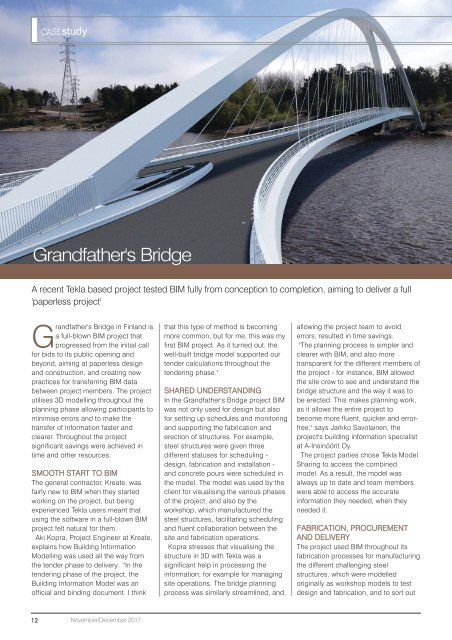You also want an ePaper? Increase the reach of your titles
YUMPU automatically turns print PDFs into web optimized ePapers that Google loves.
CASE study<br />
Grandfather's Bridge<br />
A recent Tekla based project tested BIM fully from conception to completion, aiming to deliver a full<br />
'paperless project'<br />
Grandfather's Bridge in Finland is<br />
a full-blown BIM project that<br />
progressed from the initial call<br />
for bids to its public opening and<br />
beyond, aiming at paperless design<br />
and construction, and creating new<br />
practices for transferring BIM data<br />
between project members. The project<br />
utilises 3D modelling throughout the<br />
planning phase allowing participants to<br />
minimise errors and to make the<br />
transfer of information faster and<br />
clearer. Throughout the project<br />
significant savings were achieved in<br />
time and other resources.<br />
SMOOTH START TO BIM<br />
The general contractor, Kreate, was<br />
fairly new to BIM when they started<br />
working on the project, but being<br />
experienced Tekla users meant that<br />
using the software in a full-blown BIM<br />
project felt natural for them.<br />
Aki Kopra, Project Engineer at Kreate,<br />
explains how Building Information<br />
Modelling was used all the way from<br />
the tender phase to delivery. "In the<br />
tendering phase of the project, the<br />
Building Information Model was an<br />
official and binding document. I think<br />
that this type of method is becoming<br />
more common, but for me, this was my<br />
first BIM project. As it turned out, the<br />
well-built bridge model supported our<br />
tender calculations throughout the<br />
tendering phase."<br />
SHARED UNDERSTANDING<br />
In the Grandfather's Bridge project BIM<br />
was not only used for design but also<br />
for setting up schedules and monitoring<br />
and supporting the fabrication and<br />
erection of structures. For example,<br />
steel structures were given three<br />
different statuses for scheduling -<br />
design, fabrication and installation -<br />
and concrete pours were scheduled in<br />
the model. The model was used by the<br />
client for visualising the various phases<br />
of the project, and also by the<br />
workshop, which manufactured the<br />
steel structures, facilitating scheduling<br />
and fluent collaboration between the<br />
site and fabrication operations.<br />
Kopra stresses that visualising the<br />
structure in 3D with Tekla was a<br />
significant help in processing the<br />
information; for example for managing<br />
site operations. The bridge planning<br />
process was similarly streamlined, and,<br />
allowing the project team to avoid<br />
errors, resulted in time savings.<br />
"The planning process is simpler and<br />
clearer with BIM, and also more<br />
transparent for the different members of<br />
the project - for instance, BIM allowed<br />
the site crew to see and understand the<br />
bridge structure and the way it was to<br />
be erected. This makes planning work,<br />
as it allows the entire project to<br />
become more fluent, quicker and errorfree,"<br />
says Jarkko Savolainen, the<br />
project's building information specialist<br />
at A-Insinöörit Oy.<br />
The project parties chose Tekla Model<br />
Sharing to access the combined<br />
model. As a result, the model was<br />
always up to date and team members<br />
were able to access the accurate<br />
information they needed, when they<br />
needed it.<br />
FABRICATION, PROCUREMENT<br />
AND DELIVERY<br />
The project used BIM throughout its<br />
fabrication processes for manufacturing<br />
the different challenging steel<br />
structures, which were modelled<br />
originally as workshop models to test<br />
design and fabrication, and to sort out<br />
12<br />
November/December 2017

















